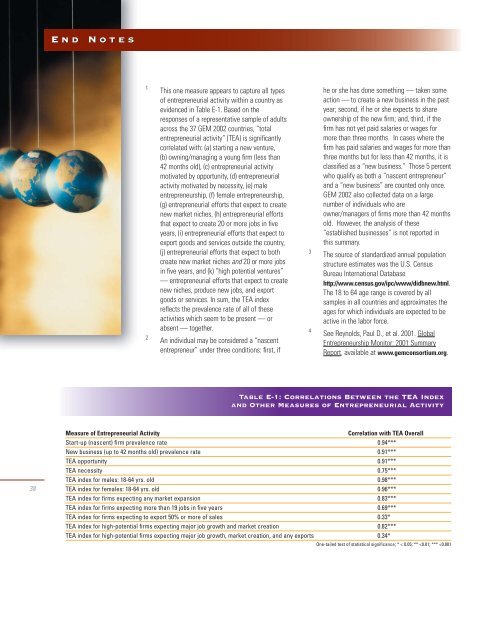Global entrepreneurship report - ResearchGate
Global entrepreneurship report - ResearchGate
Global entrepreneurship report - ResearchGate
Create successful ePaper yourself
Turn your PDF publications into a flip-book with our unique Google optimized e-Paper software.
End Notes<br />
1<br />
2<br />
This one measure appears to capture all types<br />
of entrepreneurial activity within a country as<br />
evidenced in Table E-1. Based on the<br />
responses of a representative sample of adults<br />
across the 37 GEM 2002 countries, “total<br />
entrepreneurial activity” (TEA) is significantly<br />
correlated with: (a) starting a new venture,<br />
(b) owning/managing a young firm (less than<br />
42 months old), (c) entrepreneurial activity<br />
motivated by opportunity, (d) entrepreneurial<br />
activity motivated by necessity, (e) male<br />
<strong>entrepreneurship</strong>, (f) female <strong>entrepreneurship</strong>,<br />
(g) entrepreneurial efforts that expect to create<br />
new market niches, (h) entrepreneurial efforts<br />
that expect to create 20 or more jobs in five<br />
years, (i) entrepreneurial efforts that expect to<br />
export goods and services outside the country,<br />
(j) entrepreneurial efforts that expect to both<br />
create new market niches and 20 or more jobs<br />
in five years, and (k) “high potential ventures”<br />
— entrepreneurial efforts that expect to create<br />
new niches, produce new jobs, and export<br />
goods or services. In sum, the TEA index<br />
reflects the prevalence rate of all of these<br />
activities which seem to be present — or<br />
absent — together.<br />
An individual may be considered a “nascent<br />
entrepreneur” under three conditions: first, if<br />
3<br />
4<br />
he or she has done something — taken some<br />
action — to create a new business in the past<br />
year; second, if he or she expects to share<br />
ownership of the new firm; and, third, if the<br />
firm has not yet paid salaries or wages for<br />
more than three months. In cases where the<br />
firm has paid salaries and wages for more than<br />
three months but for less than 42 months, it is<br />
classified as a “new business.” Those 5 percent<br />
who qualify as both a “nascent entrepreneur”<br />
and a “new business” are counted only once.<br />
GEM 2002 also collected data on a large<br />
number of individuals who are<br />
owner/managers of firms more than 42 months<br />
old. However, the analysis of these<br />
“established businesses” is not <strong>report</strong>ed in<br />
this summary.<br />
The source of standardized annual population<br />
structure estimates was the U.S. Census<br />
Bureau International Database<br />
http://www.census.gov/ipc/www/didbnew.html.<br />
The 18 to 64 age range is covered by all<br />
samples in all countries and approximates the<br />
ages for which individuals are expected to be<br />
active in the labor force.<br />
See Reynolds, Paul D., et al. 2001. <strong>Global</strong><br />
Entrepreneurship Monitor: 2001 Summary<br />
Report, available at www.gemconsortium.org.<br />
Table E-1: Correlations Between the TEA Index<br />
and Other Measures of Entrepreneurial Activity<br />
38<br />
Measure of Entrepreneurial Activity<br />
Correlation with TEA Overall<br />
Start-up (nascent) firm prevalence rate 0.94***<br />
New business (up to 42 months old) prevalence rate 0.91***<br />
TEA opportunity 0.91***<br />
TEA necessity 0.75***<br />
TEA index for males: 18-64 yrs. old 0.98***<br />
TEA index for females: 18-64 yrs. old 0.96***<br />
TEA index for firms expecting any market expansion 0.83***<br />
TEA index for firms expecting more than 19 jobs in five years 0.69***<br />
TEA index for firms expecting to export 50% or more of sales 0.33*<br />
TEA index for high-potential firms expecting major job growth and market creation 0.82***<br />
TEA index for high-potential firms expecting major job growth, market creation, and any exports 0.34*<br />
One-tailed test of statistical significance; * < 0.05; **
















